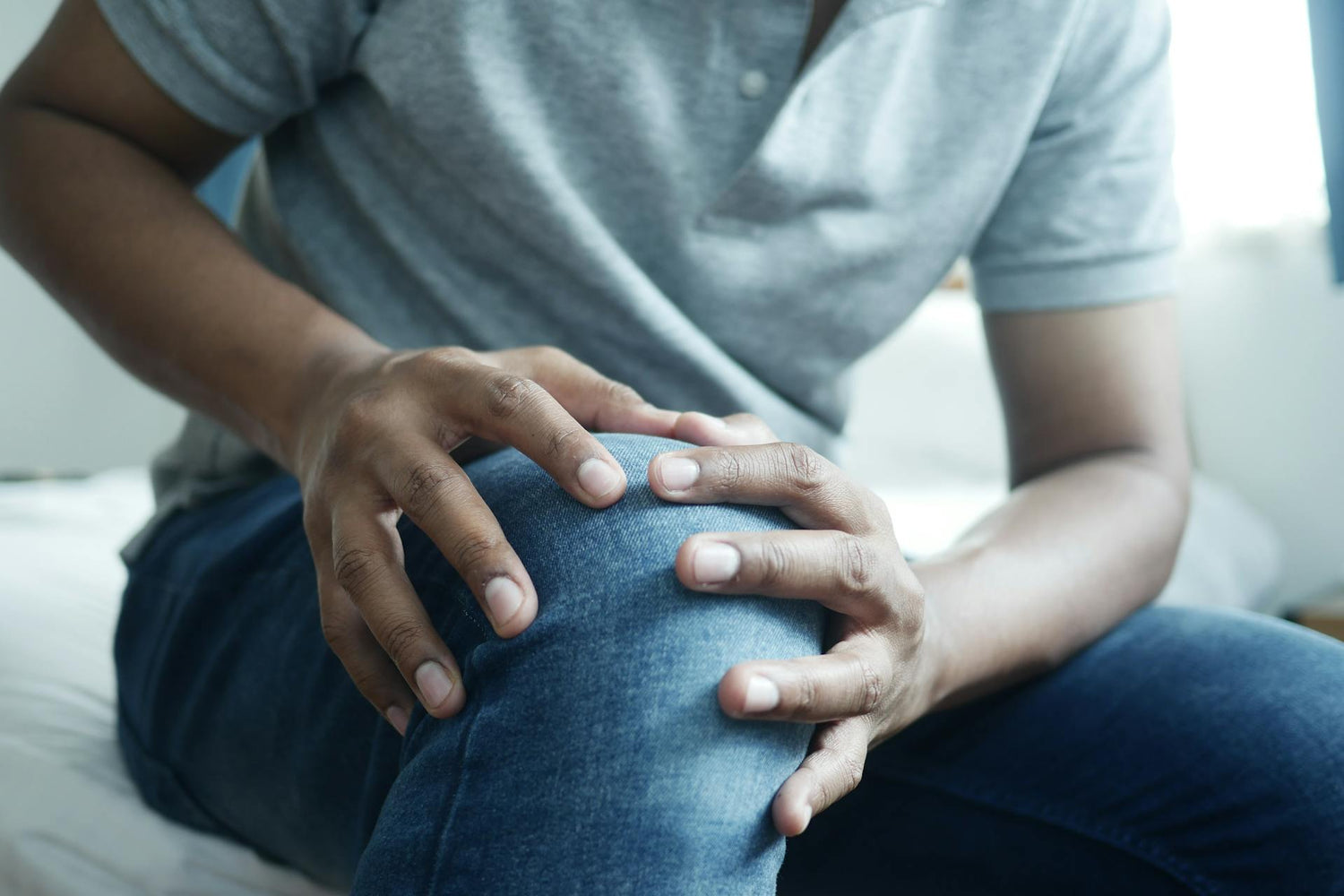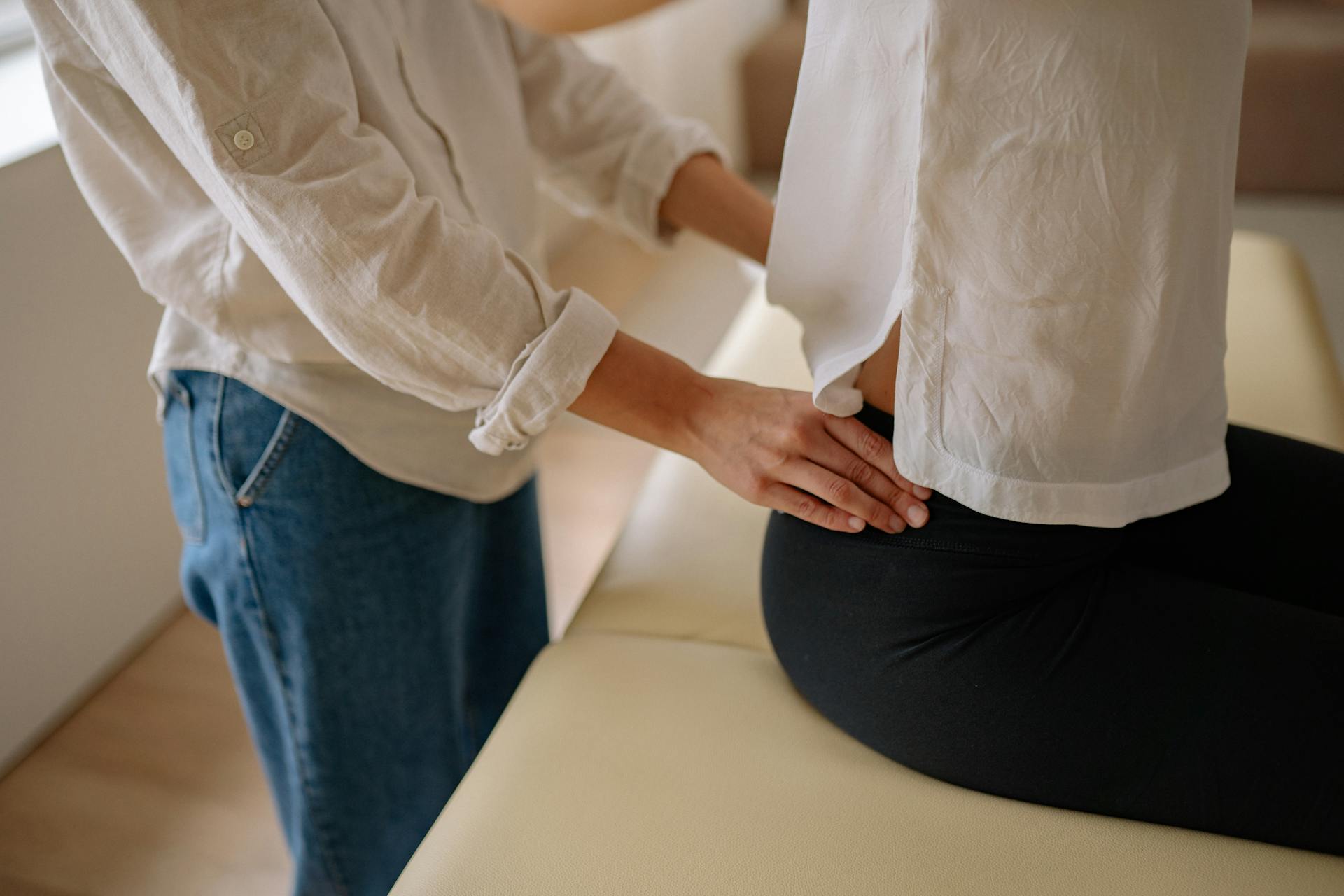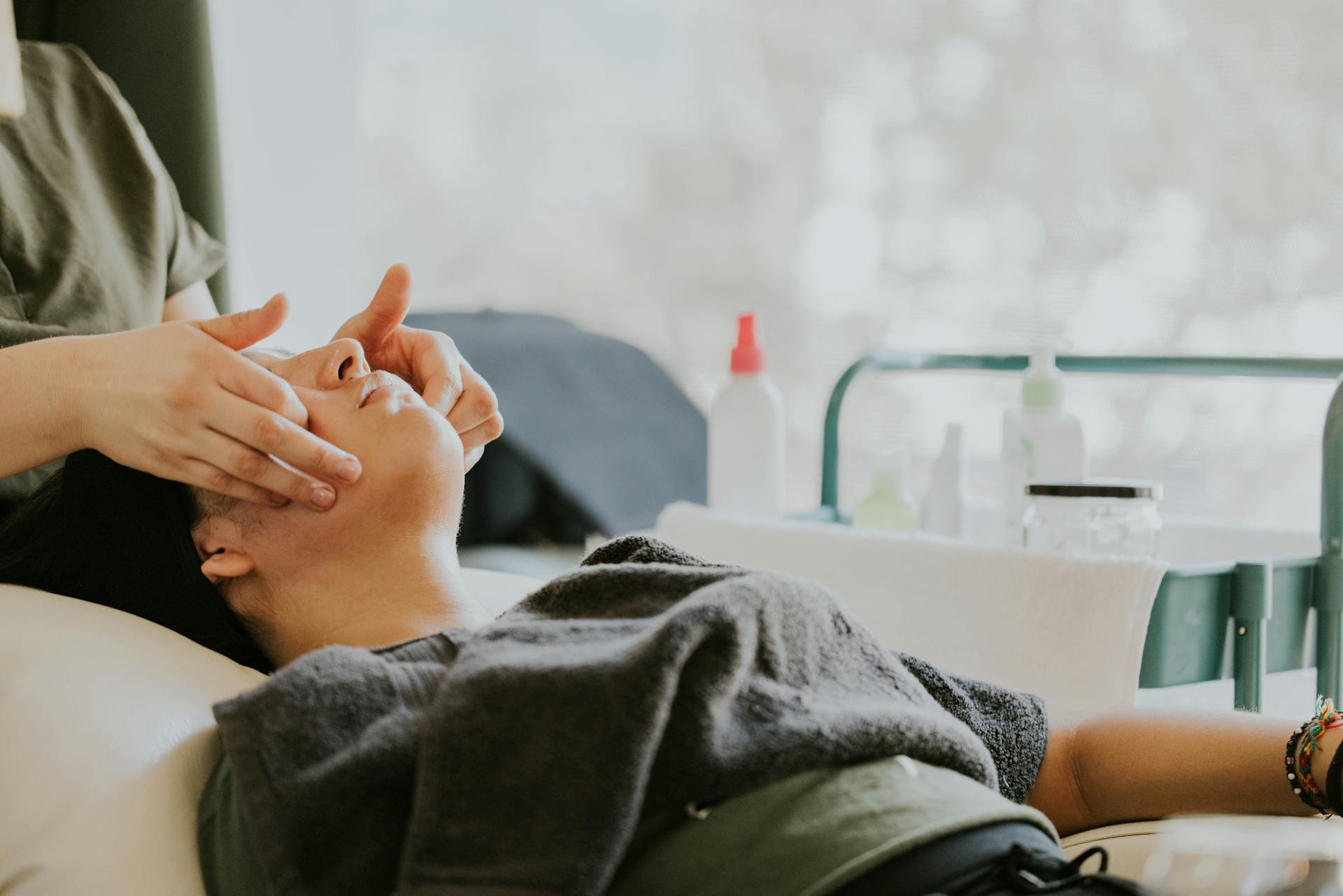While winter can majorly affect our health and mood, it turns out that the chilly temperatures can impact our knees, too. Frigid air can bring pressure shifts and muscle tension that triggers or worsens joint pain, especially for those with osteoarthritis (OA). And a 2007 survey even found that for every 10-degree drop in temperature, OA knee pain seems to get worse.
Whether you have arthritis pain all year round or simply noticed that your knees feel a little achier in the winter, the good news is that there are tools that can help.
From in-the-moment self-massage to heat and more, read on to discover seven powerful remedies for knee pain in cold weather.
Why Does Knee Pain Get Worse in Cold Weather?
As we get older, cold weather tends to bring on more aches and pains — and our knees feel it, too.
One main theory as to why this happens is that cooler temperatures affect barometric pressure, which can impact joint and muscle tissue. As a result, our knees may start to feel stiffer, more painful, and less mobile in the cold.
Your knees also contain synovial fluid, which provides cushioning and lubrication that allows them to bend and rotate freely. This fluid can thicken in response to pressure and temperature changes, adding to that familiar achiness in chilly weather.
When you’re cold, your body also automatically tenses your muscles to conserve warmth — making already ache-prone knees feel even more stiff and painful. Some other factors that may add to cold-weather knee pain include:
Lifestyle Changes
Studies have shown that we as humans tend to be much more active in the warmer months. And while it makes sense to spend more time indoors when it’s cold outside, our sedentary wintertime lifestyle shifts can take a toll on our joints. This is because:
- Less activity can lead to stiffer muscles, which can contribute to winter knee pain.
- Winter and holiday weight gain can put additional pressure on the knees. According to the Arthritis Foundation, one extra pound of weight can put four more pounds of pressure on these busy joints.
- Weakened leg muscles can mean that there’s less support and stability around the knees as a whole.
Arthritis
Aside from stiff muscles and lifestyle conditions, arthritis is another major factor in cold-weather knee pain. While anyone can feel more discomfort in the cold, the joint damage that often comes with arthritis can make the knees even more vulnerable to pressure and temperature changes.
Many kinds of knee arthritis can cause pain in the winter, but the most common type is osteoarthritis (or wear-and-tear arthritis). This condition will affect nearly 1 in 2 people at some point in their lives, and it tends to become more noticeable with age.
How Cold Weather Affects Knee Health
Although cold weather can’t damage the knees directly, it can still pose some extra risks for knee health.
Aside from general stiffness and achiness, the reduced blood flow and lower vitamin D levels that can come with the chilly seasons may affect the time it takes for your body to deal with inflammation and injuries.
Plus, if you have a previous injury or a chronic condition like OA, you may be at higher risk of new injuries in the wintertime. Aside from ice-related slips and falls, the cold can make your tendons and muscles less elastic and flexible — making it easier to pull a muscle or otherwise injure the joints.
7 Remedies for Knee Pain in Cold Weather: Heat, Massage, & More

Whether your knees are more sensitive to the cold because of arthritis, muscle stiffness, or the natural wear and tear of age, here are seven remedies that could help:
1. Warm Bath or Heating Pad
Since cold can restrict blood flow and increase muscle tension, the easiest way to relieve (and prevent) winter knee pain is to keep your body warm. By adding some heat to your knees, it can help boost circulation, relax the muscles, and support the healthy flow of fluid in the joints.
Some easy ways to try heat for winter knee pain include:
- A hot, damp towel or warm bath. Moist heat can be extra soothing because it more quickly reaches deeper levels of muscle tissue.
- A heating pad. While a hot bath or towel can be relaxing, they’re not always the most practical options. Heating pads can be a great choice when you’re at home and need an easier, all-day way to stay warm.
- Hand warmers. These are an affordable and handy option when you need to warm up on the go.
2. Add Support With a Knee Brace
While knee braces are great for acute injuries, they can also be useful for cold weather-related knee pain. On top of trapping in extra heat, a quality knee brace can help offset the effects of muscle stiffness by adding more support to your knee. Plus, its gentle compression can promote healthy blood flow in and around the joint.
If you decide to try a knee brace, remember to:
- Find one with the right fit. Depending on your knee health and history, it can help to check with your doctor for recommendations.
- Consider a thermal knee brace. Options made with heat-trapping fabric can be extra soothing in the cold seasons.
- Use it when you’re up for the day. These tools are great when you’re up and moving around, but compression while sleeping may reduce circulation or cause soreness if your knee is locked in the same position all night.
3. Try Knee Stretches and Strengthening Exercises
Another remedy for knee pain in cold weather? Add leg stretches and strengthening exercises into your routine a few times per week.
Exercise can seem counterintuitive when you’re feeling achy and stiff, but the truth is that keeping your leg muscles healthy may help ease pain, boost circulation, and improve mobility in the long run.
If you have arthritis or other knee-related conditions, it’s important to check with your doctor about which exercises would be best for you. Once you’ve got the green light, here are some simple movements that can help support better knee health:
Lying Hamstring Stretch
Did you know that hamstring tightness can cause or contribute to knee pain? When these muscles are tense or tight, they can pull your knees out of alignment, adding extra pressure to the joints. Luckily, the lying hamstring stretch is one easy way to reduce tension and keep these muscles flexible.
Here’s how to try it:
- Lie down on your back with your legs extended.
- Raise your left leg, and wrap both hands around the left thigh.
- Gently pull your leg toward you.
- Straighten your leg as much as you can until you feel a stretch in the hamstring.
- Hold for 10–15 seconds, and gently release.
- Repeat with the other leg.
Sit-to-Stands
Sit-to-stands are a gentle, simple exercise that can help support the natural range of motion of your knee joints, all while targeting key muscles like the quadriceps and glutes. To try them:
- Have a seat in a comfortable chair, keeping your spine neutral and supported.
- Keep your feet flat on the floor, and cross your arms over your chest.
- Push down through your heels to come into a standing position.
- Slowly sit down, and repeat for 2–3 sets of 10–15 reps.
4. Aim for a Generally Active Lifestyle
Living with joint pain — especially in the fall and winter — can make it easy to cut back on movement and exercise. And while rest and recovery are key, it turns out that living a generally active lifestyle may be equally as important for fending off knee pain. In fact, one 2020 review of studies found that physical activity may be linked to less pain and improved function in those with knee and hip osteoarthritis.
The good news is that being active (even in the cold seasons) doesn’t have to be intense or complicated. You could try options as simple as indoor cycling, swimming, or even walks on a track or treadmill to help support your knees in the fall and winter.
5. Eat an Anti-Inflammatory Diet
It’s well-known that a healthy diet can help with inflammation, as well as conditions like diabetes and heart disease. But did you know that the right foods could also be helpful for joint health and arthritis pain?
One 2024 review from the Journal of Human Nutrition and Dietetics found some evidence that limiting processed foods and replacing them with more whole, omega-3-rich foods may help boost function and ease pain in patients with OA.
If you’re not sure where to start, simply adding more whole foods to your meals is a great first step. But for more specific options to ease inflammation and support joint health, you can try opting for:
- Cruciferous vegetables like broccoli, cabbage, and cauliflower
- Leafy greens like kale and spinach
- Vibrant fruits like oranges, berries, apples, and pineapple
- Omega-3-rich foods like walnuts, sardines, and salmon
6. Self-Massage for Knee Pain
You might already know that massage can come with plenty of natural health benefits, from reducing the harmful effects of stress to easing sore muscles after workouts. But as it turns out, it may also be a powerful tool for easing joint pain that comes with cold weather.
How does it work? In short, the gentle friction of massage creates heat and supports healthy blood flow, which can help your knees get more of the oxygen and nutrients they need.
Plus, the right massage techniques may help ease stiff muscles, improve mobility, and temporarily relieve knee pain. A 2022 review of studies even found that massage seemed to have temporary benefits for stiffness, pain, and functionality in patients with knee OA.
Quadriceps Foam Roll
If you have a workout enthusiast in your life (or are one yourself), you’ve probably heard about foam rolling. Foam rolling involves a type of massage called self-myofascial release (SMR), which can be great for working out deep tension in large muscle groups around the knees — including the quads. Here’s how to try it:
- Place your foam roller on the ground in front of you.
- Get into a tabletop position, and place the foam roller horizontally in front of your left thigh.
- Lean down onto your elbows with your fingers interlocked, and extend your left leg straight out behind you. As you do so, bend your right knee out to the right for support. Your left thigh should now be resting on the foam roller.
- Lean into the foam roller with moderate pressure.
- Using your arms and right leg to support your body weight, slowly roll up and down the length of the thigh. Repeat for 30–60 seconds.
- Repeat with the other leg.
Hands-On Massage
When it comes to remedies for cold-weather knee pain, hands-on massage can be another fantastic option. While it can be a little more tiring than other techniques, the upside is that it can be used anytime, anywhere — without the need for any tools.
The next time you feel that familiar knee ache from the cold, here’s a simple hands-on massage to try:
- To warm up the muscles, begin by using both hands to massage the thigh in upward, sweeping motions for 30 seconds.
- Then, place both thumbs side-by-side on the lower quad muscle, just above the knee.
- Use moderate pressure to massage in outward spreading motions up the length of the thigh for 30–60 seconds.
- Then, use both hands to lightly massage around the patella (kneecap) in circular motions for another 1–2 minutes.
- Finally, shift forward so that your glutes are on the very edge of your seat. (This way, you’ll be able to more easily reach your hamstrings.)
- Keep your leg relaxed, and interlock your fingers below the thigh.
- Using moderate pressure, push the palms together to massage the hamstring in a squeezing motion. Start at the bottom of the muscle near your knee, and repeat the motion up toward the glutes.
- Repeat with the other leg.
Using a Body Massager
Tools like the MedMassager Body Massager Plus make it easy to massage the muscles around your knees whenever you need it most — helping to support mobility and curb pain on a regular basis.
To try this massager on the quads and hamstrings:
- Stand or sit with your legs extended over the edge of a chair or couch.
- Set your massager to its lightest setting.
- Glide the massager over your left quad muscle for 20–30 seconds to warm up the tissue.
- Repeat with the left hamstring muscle.
- Dial up the pressure to your preferred intensity.
- Gently glide the massager up and along both muscle groups for another 5-10 minutes. (Note: Be sure to focus on the muscles around the knee joint, rather than the cartilage or bones themselves.)
- Repeat with the right leg.
7. Pain Medication or Topical Treatments
When a warm bath or gentle massage doesn’t seem to do the trick, pain medications and topical creams can also help you manage knee pain in cold weather.
If you have a condition like arthritis, it’s important to ask your doctor about which medications could work best on the days that you experience flare-ups. They may recommend options like:
- Over-the-counter pain relievers like acetaminophen or ibuprofen. It’s best not to use these too much or too often, but they can be helpful when the pain isn’t responding to other remedies.
- Topical creams or ointments that contain capsaicin, menthol, or other soothing ingredients.
When Should You See a Doctor About Knee Pain in Cold Weather?
The good news is that mild cold-weather knee pain isn’t always something to worry about. If it’s not a sudden or new symptom — and it doesn’t get in the way of your daily life — it can often be managed at home with the help of the right self-care tools.
But if you’ve noticed knee pain that’s sudden, severe, or persistent — or you’re having trouble walking or putting weight on your knees — be sure to schedule a visit with your doctor. In addition, it’s important to see a healthcare professional if you notice swelling, warmth, clicking, or popping, or if you think that you may have injured your knee.
The Takeaway
Because of the pressure changes and muscle stiffness that can come with chilly temperatures, knee pain in the fall and winter is all too common. Thankfully, there are many remedies that can help — ranging from long-term options like stretching and staying active to in-the-moment remedies like warmth and massage therapy.
If you’re curious about using regular massage to relax and support the muscles around your knees, the tools from MedMassager can help. Pick up the MedMassager Body Massager Plus today to get started, or learn more about its many restorative uses here.



